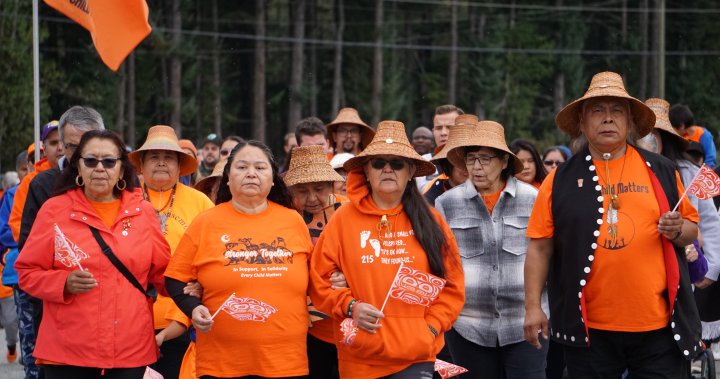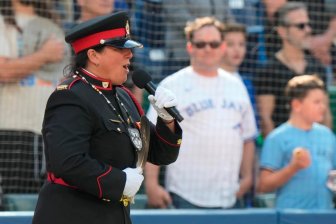‘I’m speaking for you now’: Haisla residential school survivors march for their ancestors
Warning: This story deals with disturbing subject matter that may upset and trigger some readers. Discretion is advised.
Darleen Wilson vividly remembers the day she was taken from her family and shipped to St. George’s Residential School in Lytton. It was more than 1,000 kilometres away from her home in the Haisla Nation on the north coast of British Columbia.
“I remember them taking us off the train and putting us in boxcars, and telling us we were nothing but a heard of cattle,” she said, standing by a memorial for Haisla children who attended institutions of assimilation across the province.
“The first thing they did was undress us, took all our clothes, cut off all our hair and poured white stuff all over us. That’s my memory of my first time going to residential school.”
Residential school survivor Darleen Wilson marches on Truth and Reconciliation Day at the Haisla Nation in Kitimaat, B.C. on Sept. 30, 2023.
Elizabeth McSheffrey/Global News
The Haisla Nation, as it’s known today, is an amalgamation of two bands that have occupied the land since time immemorial, the Kitimaat and the Kitlope. Its primary village of Kitimaat — Cʼimaucʼa in Haisla — sits at the head of the Douglas Channel.
Its citizens marched for residential school survivors long before the federal government declared Sept. 30 National Day for Truth and Reconciliation in 2021. On Saturday, dozens donned orange shirts once more, held hands, drummed and sang in a walk around the village.
“For me, it’s honouring our grandparents and our parents, our aunts and uncles. Every year, we do these walks and we do it for them, because they were never able to,” said Ramona Adams, who survived St. Michael’s Indian Residential School in Alert Bay, B.C.
“That’s my way of honouring them and letting them know, I’m speaking for you now.”

Canada’s harrowing residential school system was operated by the church and state in an effort to erase Indigenous languages, identities and cultures. Those who ran them — primarily priests and nuns — used religious doctrine, isolation, forced starvation, and sickening physical and sexual abuse as tools of assimilation.
The Catholic Church operated nearly three quarters of the prison-like schools. More than 150,000 Indigenous children were seized beginning in the 1830s, and ending when the last residential school closed in 1996.
An unknown number of children — many thousands — never returned home.
A memorial to Haisla Nation children who attended residential schools is seen in Kitimaat, B.C. on Sept. 30, 2023.
Elizabeth McSheffrey/Global News
On Saturday, Haisla survivors wept at the memorial for the missing children, underneath which little shoes and stuffed animals are buried. They laid orange roses and small orange flags, decorated in traditional Haisla design.
Across Canada, First Nations are conducting ground-penetrating radar sweeps of former residential school sites in an effort to quantify the number of little ones who died there and bring their remains home to their loved ones.
More than 2,000 suspected unmarked graves have been detected to date from coast to coast.
The reunion between missing children and their families is an outcome Wilson said she prays for every day. In the interim, she said the intergenerational survivors and youth are helping pave the way for healing.
“When I started having children, I didn’t know how to love,” Wilson told Global News, surrounded by her grandchildren.
“I never hugged, but that’s what the survivors of the survivors did for us. These are my rocks here. They don’t realize how much they have helped us.”

Eight years have passed since the Truth and Reconciliation Commission, appointed to uncover the grisly reality of residential schools, released its findings of “cultural genocide.” A little over a year has passed since Pope Francis took that finding one step further, acknowledging what happened in the schools was genocide.
Janice Grant, also a survivor of St. Michael’s Indian Residential School, said she’s pleased to see the truth discussed more openly, no longer concealed behind the closed colonial doors.
“Ask questions. Listen. Talking is healing. Listening is learning,” she said, of how non-Indigenous Canadians can support truth and reconciliation.
Like Wilson, she said friends, family and grandchildren have filled her with hope and helped her heal.
“I seen my granddaughter two months ago. When she first joined the dance group she was 10. That’s the age I was when I was taken,” Grant recalled. “I sat in the crowd and cried … thanking our creator that there’s no longer residential school.”

Adams bravely watched the demolition of St. Michael’s in Alert Bay, in-person, in February 2015. She said she cried in “relief” as the haunting, red brick building crumbled before her.
That was her second return to the place that had imprisoned her. Her first was in 2010, when she said she spent some of her federal residential school settlement on a visit with her husband.
“I said, I’m going back to that school and I’m going to take back that little girl that I left behind,” Adams told Global News, standing next to her sister Roberta Duncan, who is also a survivor.
“That’s what I did. To see that little girl, running down that flight of stairs in that little blue dress with pastel flowers on it — she came and jumped into my arms and I knew we were going to be okay.”
Haisla Nation survivors Roberta Duncan and Darleen Wilson lay flags at a memorial for children who attended residential school in Kitimaat, B.C. on National Day for Truth and Reconciliation.
Elizabeth McSheffrey/Global News
Leonard Paul, who went to St. Michael’s as well, said his people have always understood reconciliation. After 10 years of imprisonment — five which passed without a single family visit — he said he wouldn’t wish a single one of his experiences there on anyone.
“I felt those healing spirits from our fathers, ancestors. It was a beautiful feeling to have,” he said, citing a deep “love of our people.”
“Even today, I seen how it is in the rec centre — all the love from all the people, people from town — it was awesome to see.”
The Truth and Reconciliation Commission has released 94 Calls to Action bringing Indigenous and non-Indigenous Canadians together to right past wrongs, which all Canadians are encouraged to read and act upon.
The National Inquiry for Missing and Murdered Indigenous Women and Girls has also released 231 Calls for Justice aimed at ending the crisis of violence and poverty facing First Nations, Inuit and Métis women, girls and 2SLGBTQIA+ people.
The Indian Residential Schools Crisis Line (1-866-925-4419) is available 24 hours a day for anyone experiencing pain or distress as a result of their residential school experience.
The Hope for Wellness Help Line offers culturally competent counselling and crisis intervention to all Indigenous peoples experiencing trauma, distress, strong emotions and painful memories. The line can be reached anytime toll-free at 1-855-242-3310.




